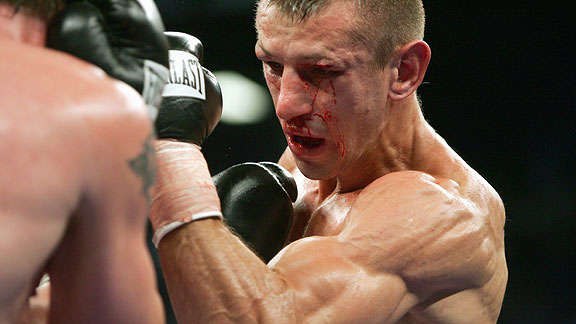Our ideal body isn’t found in the bodybuilding magazines, or at the Mr. Olympia event. If you think about it, it’s found much more often on the football field every sunday, or the boxing ring, the octagon, or on the track. We see it in men’s fitness magazines, not bodybuilding magazines. We don’t want to bulk up way beyond our current weight, then have to cut down when ‘the season’ comes. We’d rather be in great shape year-round.
The problem we face is that the bodybuilding method of bulking and cutting dominates the internet, the magazines, and any other form of literature we can find on the subject. They teach us how to build muscle and lose fat for part of the year, but not how to stay in great shape year-round.

Dr. Steelhammer, Wladimir Klitschko, chopping wood for his pre-fight training.
So how do the athletes I just mentioned stay in such great shape 365 days a year? Is there some method or theory that we can learn from them to achieve the same thing?
Yes, actually there is. I’ve stayed at the same weight, kept a 6-pack, and improved in conditioning over the past couple of years, and I’m going to help you do the same thing with this series of articles. You see, athletes don’t train like bodybuilders. Their goals aren’t to bulk, then cut. Their goals are purely focused on performance – which, as you’ll soon read, is the reason for their impressive results.
I’m going to give you unique training tips, nutrition tips, and goal-setting and motivation techniques that have helped me, and will help you build a ripped physique and keep it year-round. I’ll also give you some great resources from people other than myself that will help you on your path to building your ideal body.
Today we’re going to talk about the basics: how we should attack this goal from a mental standpoint and we’re also going to get into some nutritional strategies as well. Then we’ll get into unique training strategies that you can add to any program or meal plan to expedite the process in a few days. So, without further adieu, let’s get started.
First, setting the right goals
We aren’t after any quick fixes. All of our goals need to be sustainable. To get ripped, and stay ripped year-round, a lifestyle change has to occur. If you’re not shredded right now, you’re not doing the right things every day. Don’t worry, the right things aren’t always massive alterations. This is a process that can take only a few small changes over time to your routine in order to start seeing results that won’t go away.
Build a strong foundation
Don’t aim for a 180 degree change in your life right away. Set small, achievable goals, then build upon them (I’ll be giving you the changes you can make in the next couple of articles).
Set a short goal, then reward yourself. When you first start out and you’ve found the right program to use (we’ll talk about this in the training article), set a 2-3 week goal of following that program to a tee for those first 3 weeks, then reward yourself. The reward is necessary. Take a week off, go to a movie, have a massive cheat day. As you progress, keep setting longer, more difficult goals that will help you turn this into a lifestyle, not just a fad.
Forget about the inches and focus on the reps
Our goals should have nothing to do with the end result and everything to do with the process.
So many athletes have our ideal physique because they aren’t as concerned with building an ideal physique. Instead they’re much more concerned with what brings home the bacon: their improved performance. Athletes see better results in fat loss and lean muscle gains because of a relentless intensity in their training, but also because they’re so focused on lifting heavier weights for more reps while taking shorter rest periods.
The result of this ‘performance-focused’ training mentality is a greater spike in heart rate (more fat loss), greater muscle damage (more muscle gains), and improved cardiovascular capacity (a greater ability to train at a high level for longer periods of time).
Try and improve each and every time you’re in the gym. Set monthly and weekly goals that are focused on this improved performance, and the aesthetics will soon follow.
Nutrition Part I: Dieting is the enemy
Dieting will keep your body fat percentage fluctuating, it won’t keep it consistently low.

